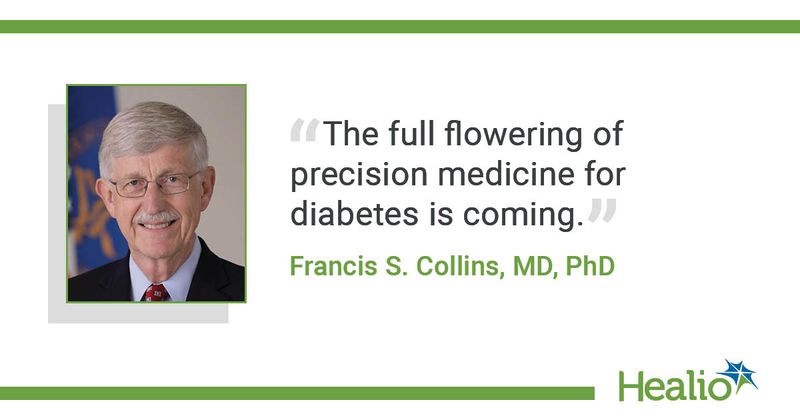Francis S. Collins: Genetic data poised to revolutionize landscape of diabetes care
SAN DIEGO — Genetic data gleaned from an ongoing “-omics” revolution are providing new insights for the prevention and treatment of diabetes that will dramatically change clinical care within the next 10 years, according to a speaker.
“Genomic science is playing a major role in unraveling the causes and the means for prevention and treatment of diabetes,” former NIH Director Francis S. Collins, MD, PhD, who gave the keynote presentation at the American Diabetes Association Scientific Sessions, told Healio. “The full flowering of precision medicine for diabetes is coming, where individual differences in genes and environmental exposures will optimize decisions about lifestyle and therapeutic interventions.”

Many ‘types’ of diabetes
The concept of “type 1” and “type 2” diabetes is being redefined in real time thanks to discoveries yielded from genetic data in the landmark Human Genome Project, which will utilize health data from hundreds of thousands of Americans to enhance disease prevention and treatment efforts. Genetic data from genome-wide association studies have revealed at least eight “subtypes” of diabetes, each with its own natural history and response to prevention and treatment modalities, said Collins, who was also director of the Human Genome Project.
“It is time to get beyond lumping [of diabetes types] and do some splitting,” said Collins, currently intramural researcher for the National Human Genome Research Institute.
Within the next decade, many patients will have their genome sequence in their medical record, allowing for a more refined endotype diagnosis, Collins said.
“There will be a lot of advances in the next 10 years related to heterogeneity,” Collins said. “Type 1 diabetes and type 2 diabetes will both be redefined with endotype subsets that will be quite significant in terms of management. Polygenic risk scores will assist in precision prevention, and they will be ancestry-specific and they will reflect these subsets.”
NIH has invested in many follow-ups to the Human Genome Project seeking to “decorate” the genome sequence with real information about function, all while making the information immediately accessible to scientists, Collins said.
“One of the things we focused on was the opportunity to use information about human variation to take apart the complexity of common diseases like diabetes,” Collins said.
Emerging research suggests the eight diabetes endotypes have genetic variants that predispose a person to diabetes appearing in different “clusters” with different weight, Collins said. He encouraged clinicians to get involved in the Rare and Atypical Diabetes Network (RADIANT) that is conducting research to discover and classify new types of diabetes.
“This is an interesting start toward beginning to take the genetic architecture of type 2 diabetes apart,” Collins said. “If you are seeing in the clinic rare forms of diabetes that do not quite fit the description — not quite type 1, type 2, [maturity-onset diabetes of the young (MODY)] or one of the others we have a name for — participate in the RADIANT program that is trying to see what else is going on.”
Using genetic data to predict drug response
As researchers learn more about diabetes endotypes and genetic risk, it will be difficult to make lifestyle and drug prescription recommendations without looking at the genome, particularly when it comes to pharmacogenomics, Collins said.
“We know that your ability to get good results from a prescribed drug is affected by a number of things, but some of it is your own inherited DNA,” Collins said. “You will have a different way of metabolizing or responding to a therapeutic. We know that already from a number of drugs, but this has not yet found its way into general application, in part because patients do not have their genome sequence sitting there in the medical chart. That is going to change as more and more people have that information collected. It costs less than $1,000 now for a whole genome.”
Pharmacogenetic research is particularly important as more data become available for blockbuster GLP-1 receptor agonists like semaglutide (Wegovy, Novo Nordisk). In trials, some participants lost a large percentage of body weight, whereas some do not respond to the drug at all. Collins encouraged trialists researching incretin agonists, in particular, to measure participant DNA to stratify who was a responder to therapy and who was not.
“Some people do not respond, and why is that?” Collins said. “It might be because the receptor the drug is supposedly an agonist for does not actually stick to it appropriately.”
Therapeutics will continue to advance, with some coming out of new pathways discovered from the -omics approach, Collins said.
“Those new generations of therapeutics will be emerging, certainly before 10 years,” Collins said.
References:
- All of Us Research Project. allofus.nih.gov. Accessed June 23, 2023.
- Rare and Atypical Diabetes Network. atypicaldiabetesnetwork.org. Accessed June 23, 2023.

